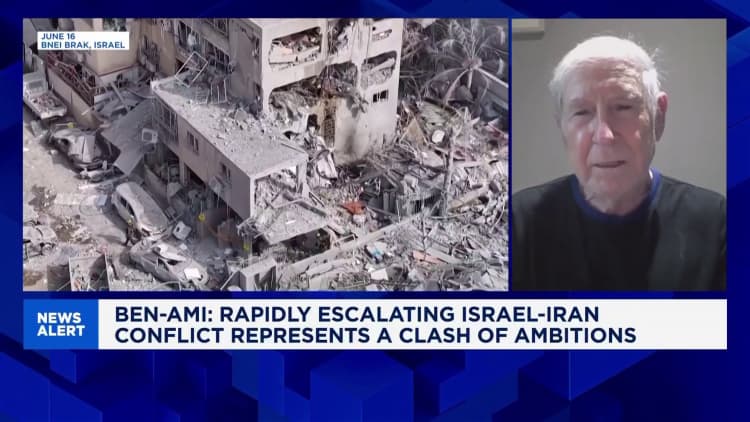A KC-135 Stratotanker aircraft refuels a B-2 Spirit aircraft with the 509th Bomb Wing over Kansas Aug. 29, 2012.
U.S. Air Force photo
DUBAI, United Arab Emirates — Iran is staring down the possibility of seeing its most important nuclear facilities hit by a 30,000-pound American bomb.
White House officials on Tuesday told NBC News that U.S. President Donald Trump is considering a range of options including striking Iran directly, after the American leader repeatedly asserted that his administration would not allow Iran to continue its nuclear program or reach bomb-making capability.
Trump called for Iran’s “unconditional surrender” and wrote in a post on Truth Social that the U.S. has the ability to assassinate Iranian Supreme Leader Ayatollah Ali Khamenei.
“He is an easy target, but is safe there – We are not going to take him out (kill!), at least not for now,” Trump wrote shortly after declaring “total control” over Iranian airspace.
The rapidly escalating conflict, triggered by Israel’s surprise attacks on Iranian military and nuclear facilities on June 13, has sent oil prices surging and put a region on edge. Initially encouraging of diplomatic talks with Tehran, Trump’s statements have become increasingly threatening as populations across the Middle East brace for what comes next.
But destroying Iran’s nuclear program — which Tehran asserts is for civilian energy purposes only — is no easy feat.
Iran’s most advanced and hardened nuclear facility, the Fordow plant in the country’s northwest, is a fortress.
Built inside a mountain some 300 feet underground and reinforced by layers of concrete, the plant — which is the most likely target of a potential American strike — is impenetrable by any bomb except the GBU-57 Massive Ordnance Penetrator (MOP). The U.S. is the only country in the world that has this “bunker buster” weapon, as well as the only country with the aircraft capable of transporting and deploying it: the B2 Spirit stealth bomber.
Iran’s ongoing retaliatory attacks with ballistic missiles towards Israel are seen from Tel Aviv, Israel on June 17, 2025.
Mostafa Alkharouf | Anadolu | Getty Images
This is in part why Israel has been so eager for U.S. involvement in its offensive operations against Iran in addition to its defensive ones.
But a strike in itself would not be a one-and-done job, military experts say.
“So you have two challenges. You would have to drop two of these penetrators at the exact same site” and likely need multiple bombing rounds, according to David Des Roches, a professor and senior military fellow at the Near East South Asia Center for Strategic Studies at the National Defense University in Washington, D.C.
“And then you would never be precisely sure how much of the facility you’ve damaged,” he added, meaning personnel may need to be deployed on the ground.
“This leads me to believe that for those facilities, Israel will ultimately gain control of the air and then land forces on the ground, force their way into the facility by detonating the doors, and then go and place explosive charges, exfiltrate whatever intelligence they can get, and just detonate it from the inside,” Des Roches told CNBC.
Wider war for America?
Iran’s military capabilities have been severely degraded over the past few days by Israeli attacks, which have taken out substantial parts of its air defenses, ballistic missile batteries, command-and-control nodes, and dozens of top commanders.
Still, such a strike by the U.S. could trigger Iran to respond by striking at U.S. assets in the region like embassies and military bases. Trump has made clear that any attack on U.S. personnel would draw a fierce American response, which would then pull the world’s most powerful military more deeply into a regional conflict.
“The Iranians have signaled that they are ready to attack U.S. bases in the region in the event of a U.S. attack on their domestic soil,” said Gregory Brew, senior analyst on Iran and energy at risk consultancy Eurasia Group, noting that American bases in Iraq are particularly vulnerable.
“There are risks in that environment that an Iranian retaliation causes U.S. casualties, kills U.S. servicemen, and potentially compels President Trump to expand the scope of U.S. action and order additional strikes on Iran and that, of course, would threaten general escalation and drag us into not just a single operation, but potentially a protracted air campaign.”
Despite its enormous scale, the GPU-57 bunker buster would not create wide-scale damage beyond the area of the facility, Des Roches said. But it would have a “profound psychological effect on the Iranians,” he added, who have already seen significant damage and radioactive contamination risk wrought to the infrastructure of several of its nuclear sites in other parts of the country.
A further critical question remains whether the Trump administration will limit itself to targeting nuclear sites, or whether it will expand operations beyond that — something Israel’s government has also been urging, as it conveys its desire to see regime change for its longtime adversary.

“I think the conflict will end when Israel is confident that Iran has lost, for a significant period of time, the ability to make a nuclear weapon, and that its defenses are weakened enough that Israel will be able to go back and effectively disrupt any further effort by Iran to make a nuclear weapon,” Des Roches argued.
If Fordow remains operational, Israel’s attacks would barely slow Iran’s ability to build a bomb, nuclear analysts say. The decisions from the While House in the coming days will therefore prove decisive not only for the trajectory of Iran’s nuclear program, but for the survivability of the Islamic Republic’s regime as a whole.
Ali Vaez, Iran project director at non-profit Crisis Group, believes that “Iran can survive and rebuild its nuclear program,” even without a diplomatic avenue for a deal with the U.S.
“The U.S. entering the war will close the door on diplomacy,” Vaez told CNBC. “Trump might be able to destroy Fordow, but he won’t be able to bomb away the knowledge that Iran has already acquired.”
Breaking News: Politics,Aerospace and defense industry,Emerging markets,Oil and Gas,Energy,Nuclear weapons,Foreign policy,Donald Trump,United States,Iran,Politics,business news
#destroying #Irans #nuclear #program #difficult

